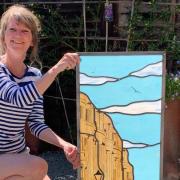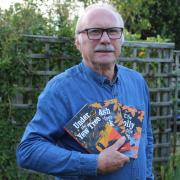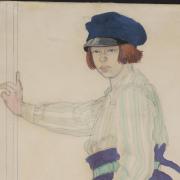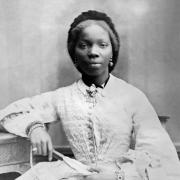Gary McCann throws open the door of a Palladian house in the corner of one of Brighton’s historic Regency enclaves. He’s all smiles, with flaming red hair and a matching beard, dressed in jeans with turn-ups, a shirt with a stand-up collar and a waistcoat.
‘Come in,’ he says, ushering me into his flat where a man and a woman with clipboards are talking animatedly.
‘Sorry - we’ve overrun on time,’ Gary apologises, introducing the interior designer and a builder, who, Gary explains, are here to look at the flat for renovation work, a tricky business as it’s in a Grade II listed building.
A highly acclaimed set and costume designer for opera, theatre and musicals, Gary bought the flat seven years ago from renowned opera director John Cox, who owned it for 40 years, while he was director of productions at the Sussex opera house Glyndebourne.

Cox’s 1975 production of Igor Stravinsky’s only full-length opera,The Rake’s Progress, at Glyndebourne, famously designed by the artist David Hockney, is considered to be the definitive staging of the opera which has been all over the world.
Working together so closely, Cox and Hockney became friends, and the artist would often visit the flat, along with the Christies, the owners of Glyndebourne.
Legend has it that Cox’s friend Christopher Lloyd, the late influential Arts & Crafts gardener of the East Sussex manor house Great Dixter, was consulted on the planting in the garden, which features an elegant white wisteria climbing through a pergola, an ancient pear tree and a Japanese peanut butter tree.

‘There is a history here,’ Gary acknowledges, ‘but there’s no central heating, it needs rewiring and a new immersion heater. The challenges are obvious - the real question is how do you retain the charm and uniqueness? I’ve got plans to inject new character into it, and not simply strip everything out and put something generic in. I want it to look 200 years old.’
But what a challenge. The flat’s quirky rooms are strangely shaped, and every surface, shelf and nook and cranny display artefacts almost as art installations. The kitchen is narrow and cramped yet stylish, a pale blue Smeg fridge sitting on chequered tiles; and the bathroom is tiny and triangular, its paintwork an orange-y yellow so the room resembles a wedge of orange cheese.
The living room has, Gary says, a Georgian feel but there are elements left by Cox that lend it an Art Deco-meets-Arts & Crafts style, such as the elaborate fire screen embellished with an orange tree motif, and the pink-framed Art-Deco mirror above it.
Gary, who turns 50 this year, has changed very little in the flat since he bought it, just a few new licks of paint colour here and there, and he has added the portraits of military men in the living room.

Now that he has decided on a renovation, though, he dreams of installing Ionic pillars in the kitchen and painting an 18th century view of palm trees in the bathroom, which would probably make a suitably theatrical setting for a man who expresses his exuberant personality by dressing in vintage suits and wears his striking beard shaped like a Russian tsar’s.
‘My look is not something I’ve engineered,’ he explains. ‘It has evolved quite naturally. I was always quite interested in classic menswear - even as a kid, I remember wearing waistcoats from the back of a cupboard. The more I’ve embraced it, the more feedback I get. If you pitch up in three-piece and a beautiful tie, people feel more comfortable.
‘As a costume designer, you’re dealing with all shapes and sizes of people and it’s your job to make them look good through flattering cuts of dresses or suits. I apply that methodology to myself. I think a man will look more distinguished in a fabulous suit.’ Then he laughs. ‘I don’t get out of bed and immediately put on a suit, but I’d like people to think I do.’
His bold approach to style seeps into every aspect of his work, where he travels the world designing spectacular sets and costumes for opera, theatre and musicals. One of the most sought-after designers in his field, he has worked on productions as diverse as the UK tours of Saturday Night Fever and The Shawshank Redemption, Cilla The Musical in Liverpool, and My Fair Lady in Turin, Italy.
This year, he is booked for a production of Turandot in Bari, (working with the legendary Italian fashion designer Roberto Capucci, who will create the costumes), Der Rosenkavalier for Irish National Opera, Phantom of the Opera in Bucharest and The Queen of Spades at The Grange Festival in Hampshire. Next year, he will be working on a yet-to-be announced production at Glyndebourne, as well as projects at Santa Fe Opera, and the Royal Opera of Muscat.

‘I’m lucky I’m in a role that affords a lot of creative freedom,’ he says. ‘Ninety per cent of the time I design both the sets and the costume, so you’ve got total creative vision.’
Before he begins designing a production, he will study plans of a theatre or go to see the space. ‘In a play, the words are important. When you’re putting on an opera, the visual is more important. You experience an opera through the power of the music and the emotions - it’s a moment in time when it all comes together. Each performance is unique, a one-off experience that can’t be repeated, and within this world the visual element is somehow elevated. It’s my job to translate this extraordinary music and the incredible power of the voices into a 3-D space that communicates the world of the opera through a stage performance.’
Music fired his imagination from a young age. Growing up on a council estate in Portadown, Northern Ireland, with his parents Ronald and Jennifer and his younger brother Darren, he was ‘freakishly interested in classical music’ and got his parents to buy him a cassette tape of Wagner’s Ride of the Valkyries after he heard it on the radio when he was 10.
When it came to studying at university, he was torn between literature, music and fine art – then he came across theatre design ‘and I thought it offered me the opportunity to do the things I love - reading and analysing scripts, being involved in the world of music in one way or another and also being a visual creative - without sacrificing any of those interests.’
He graduated from Nottingham Trent University with first class honours, and launched his career designing children’s shows, touring in the back of a van, making puppets and building sets. ‘I started off small,’ he smiles.
Gary became an assistant designer making models, and became involved in repertory theatre, including the Minerva Theatre at Chichester, and worked as art director on major TV events for Channel 4.
Then came his big break. In 2007, he designed The Pitmen Painters, a play set in the 1930s based on the true story of a group of Northumberland miners who learned to paint and produced hundreds of paintings depicting life above and below ground.
Written by Billy Elliot writer Lee Hall, it was a sellout when it opened in 2007 at Live Theatre in Newcastle. It transferred to the National Theatre’s Cottisloe in London, then toured the UK before opening on Broadway in the US.

‘The play became a sensation - before it opened at the National, it was completely sold out and had a waiting list of 50,000 people,’ says Gary. ‘It felt like hitting the jackpot with a show that became such an international success.”
After an ‘amazing’ few years he moved into opera, working first with John Cox on Beethoven’s Fidelio, at the Garsington Opera in 2009 and other opera directors.
‘By 2011 and 2012 I was doing pretty big opera productions in Norway and the Netherlands,’ he says. ‘These early productions caught people's imaginations, and so I established myself in the international opera circuit. Ten years later, I’m still running around all over the world doing opera productions.”
In the meantime, his work has been exhibited at the V&A Museum in London three times and in 2015 he was commissioned by the National Trust to create art installations in 18th century follies at Fountains Abbey in Yorkshire. In 2018, he created Curious Cabinets, a series of installations at Felbrigg Hall in Norfolk as part of the Trust New Art initiative.
Gary’s calendar continues to fill up as his reputation soars, so his unique Brighton flat is a welcome home from his globetrotting career. ‘I’ve had a long connection with Brighton and have lived here on and off for almost 20 years,’ he says. ‘The more you embrace your individuality, the better it is. There’s an openness, a freedom, an ability to express yourself. There are some really fabulous aspects to Brighton and this bohemian feeling that welcomes everybody is one of the best.’
* Visit www.garymccann.com



























